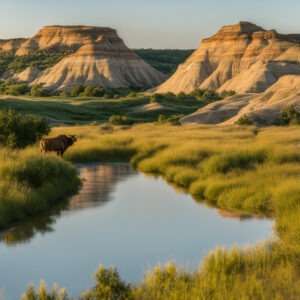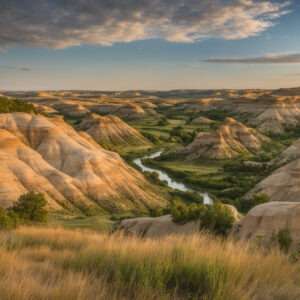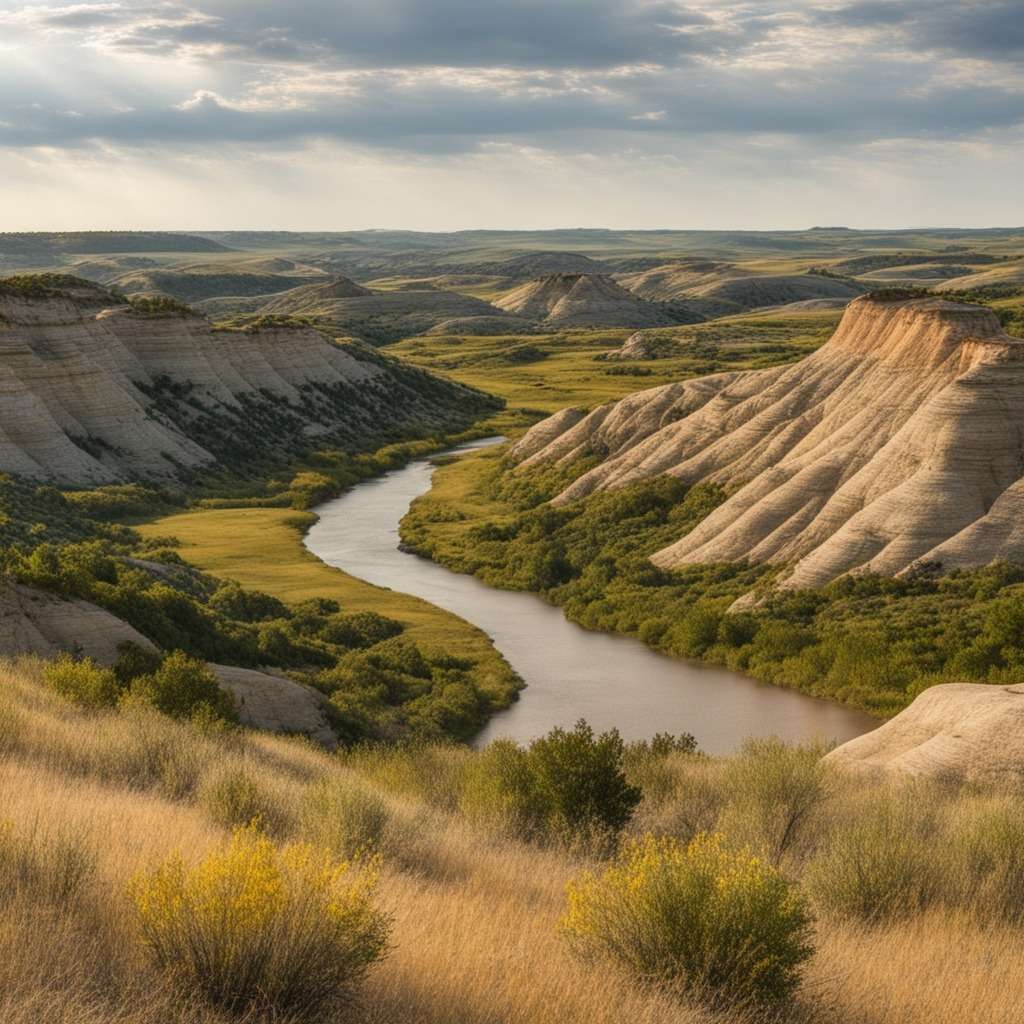Exploring Theodore Roosevelt National Park: 10 Captivating Wonders in the Heart of the Badlands
Introduction
Welcome, fellow nature enthusiasts, to the rugged and untamed beauty of Theodore Roosevelt National Park! Nestled in the heart of the Badlands, this hidden gem invites you on a journey of discovery, where every twist and turn reveals a story etched in the rocks and echoed by the winds.
Picture yourself standing atop windswept bluffs, where bison roam freely, and the sun dips below the horizon, casting a warm glow on the vast prairies. Theodore Roosevelt National Park is not just a place; it’s a living testament to the wild spirit of the American West.
In this blog, we’re about to embark on an adventure through this enchanting landscape, uncovering the seven wonders that make this park a haven for both history buffs and nature lovers alike. From the Painted Canyon to the Maltese Cross Cabin, each spot holds a unique tale waiting to be told.
So, grab your virtual hiking boots, pack your curiosity, and join us as we delve into the wonders of Theodore Roosevelt National Park – where the echoes of the past harmonize with the rustling leaves and where the call of the wild beckons you to explore every nook and cranny. Let’s dive into the magic that awaits in this captivating sanctuary of the Badlands!
Attractions in Theodore Roosevelt National Park:
Displayed in the table below are the leading 25 attractions within Theodore Roosevelt National Park, highlighting distinctive features that distinguish each site and render it remarkable.
| # | Attraction | What’s Special |
|---|---|---|
| 1 | Petrified Forest Loop | Unique trail with fossilized trees and vibrant badlands. |
| 2 | Painted Canyon Overlook | Breathtaking panoramic views of colorful canyon landscapes. |
| 3 | Wind Canyon Trail | Scenic trail along the Little Missouri River with stunning vistas. |
| 4 | Buck Hill | Excellent spot for wildlife observation, including bison and prairie dogs. |
| 5 | Boicourt Trail | Tranquil hike through varied landscapes, including grasslands and badlands. |
| 6 | Caprock Coulee Trail | Explore unique geological formations and diverse flora. |
| 7 | Badlands Overlook | Stunning views of the rugged badlands and the Theodore Roosevelt National Park. |
| 8 | Jones Creek Trail | Scenic trail featuring picturesque creek crossings and peaceful surroundings. |
| 9 | Coal Vein Trail | Walk among ancient coal veins and explore the park’s rich geological history. |
| 10 | Skyline Vista | Panoramic viewpoint offering sweeping vistas of the North Unit of the park. |
| 11 | Juniper Campground | Idyllic camping spot surrounded by the tranquility of the badlands. |
| 12 | River Bend Overlook | Scenic viewpoint overlooking the winding Little Missouri River. |
| 13 | Lower Talkington Trail | Leisurely hike through picturesque prairie landscapes. |
| 14 | Peaceful Valley Ranch | Historic site with remnants of Theodore Roosevelt’s Elkhorn Ranch. |
| 15 | Capitol Rock | Iconic rock formation with historical significance. |
| 16 | Upper Paddock Creek Trail | Traverse the park’s diverse terrain with this engaging hiking trail. |
| 17 | Roundup Group Horse Camp | Equine-friendly camping area surrounded by natural beauty. |
| 18 | Cottonwood Campground | Relaxing campground nestled amid cottonwood trees and badlands. |
| 19 | Lower Paddock Creek Trail | Explore the park’s southern reaches with this scenic hiking trail. |
| 20 | Lone Tree Loop Trail | Discover solitary trees amid the vast landscapes on this loop trail. |
| 21 | North Petrified Forest Trail | Encounter petrified wood and geological wonders along this trail. |
| 22 | Jones Creek Trailhead | Starting point for the scenic Jones Creek Trail, offering a taste of the park’s beauty. |
| 23 | Wannagan Campground | Remote camping experience surrounded by the park’s serene landscapes. |
| 24 | Elkhorn Ranch Site | Visit the historic site where Theodore Roosevelt found solace and inspiration. |
| 25 | Roosevelt’s Maltese Cross Cabin | Step back in time and explore the cabin that served as Theodore Roosevelt’s hunting retreat. |

Location and Basics:
What is Theodore Roosevelt National Park?
Theodore Roosevelt National Park, located in western North Dakota, is a testament to the untamed beauty of the Badlands. Named after the 26th President of the United States, who was instrumental in its establishment, the park spans over 70,000 acres and is divided into three units: the North Unit, the South Unit, and the Elkhorn Ranch Unit. Each unit offers a unique landscape, featuring rugged canyons, rolling grasslands, and abundant wildlife.
Where can I find Theodore Roosevelt on the map?
Theodore Roosevelt National Park is situated in western North Dakota. To locate it on the map, look for the state of North Dakota, and you’ll find the park spanning across the western region, offering a haven of natural wonders, historical sites, and outdoor activities.
What are the units of Theodore Roosevelt ?
Theodore Roosevelt National Park comprises three units: the North Unit, the South Unit, and the Elkhorn Ranch Unit. Each unit has its own distinctive features, providing visitors with diverse landscapes to explore. The North and South Units are known for their scenic drives, hiking trails, and wildlife viewing opportunities, while the Elkhorn Ranch Unit preserves the site where Theodore Roosevelt once ranched and found solace.
Camping and Accommodation:
How can I camp in Theodore Roosevelt ? Camping in Theodore Roosevelt National Park is a unique and immersive experience. Both the North and South Units offer campgrounds, providing visitors with the opportunity to sleep under the star-lit skies of the Badlands. Reservations are recommended, especially during peak seasons, to ensure availability. Additionally, dispersed camping is permitted in certain areas, allowing for a more primitive and secluded camping experience.
Where can I find campgrounds near Theodore Roosevelt ? Theodore Roosevelt National Park offers campgrounds within its North and South Units. The Juniper Campground in the North Unit and the Cottonwood Campground in the South Unit are popular choices, providing facilities amidst the breathtaking landscapes. These campgrounds offer a range of amenities, from scenic views to convenient access to hiking trails.
Are there RV camping options in Theodore Roosevelt ? Yes, Theodore Roosevelt National Park accommodates RV camping enthusiasts with designated sites in both the North and South Units. These sites often include amenities such as electric hookups and access to restroom facilities, making it a comfortable and scenic base for exploring the park.
Where can I find cabins or motels near Theodore Roosevelt ? For those seeking alternative accommodations, there are cabins and motels located near Theodore Roosevelt National Park. These options provide a comfortable stay while allowing visitors to enjoy the natural surroundings. Check with nearby towns like Medora for lodging options that cater to various preferences and travel styles.

Weather and Travel:
What is the typical weather like in Theodore Roosevelt ? Theodore Roosevelt National Park experiences a continental climate with distinct seasons. Summers are warm with temperatures ranging from 70 to 90°F, making it an ideal time for outdoor activities. Winters can be cold, with temperatures ranging from 0 to 30°F. Visitors should be prepared for temperature fluctuations and occasional precipitation throughout the year.
When is the best time to visit Theodore Roosevelt ? The best time to visit Theodore Roosevelt National Park is during the late spring and summer months, from May to September. During this period, the weather is more temperate, allowing for pleasant hiking, wildlife viewing, and camping experiences. However, each season offers its own unique charm, and even the winter months can be a serene and captivating time to explore the park.
What is the closest airport to Theodore Roosevelt, and how can I get there? The closest major airport to Theodore Roosevelt National Park is Theodore Roosevelt Regional Airport (DIK), located in Dickinson, North Dakota. From there, visitors can rent a car or use other transportation options to reach the park, which is approximately 20 miles from Dickinson.
Activities and Attractions:
What activities can I do in Theodore Roosevelt ? Theodore Roosevelt National Park offers a myriad of activities for nature lovers and outdoor enthusiasts. Visitors can enjoy hiking, wildlife watching, birding, and scenic drives. The park also provides opportunities for ranger-led programs, stargazing, and photography, allowing guests to immerse themselves in the diverse landscapes and rich history.
Are there hiking trails in Theodore Roosevelt ? Yes, Theodore Roosevelt National Park boasts a network of hiking trails that cater to various skill levels. From easy walks to challenging hikes, the trails lead through stunning landscapes, providing opportunities to encounter the park’s unique flora and fauna. Popular trails include the Wind Canyon Trail, Caprock Coulee Trail, and the Petrified Forest Loop.
What are the best hikes in Theodore Roosevelt ? The best hikes in Theodore Roosevelt National Park often include the Wind Canyon Trail, which offers panoramic views of the Little Missouri River; the Caprock Coulee Trail, known for its scenic beauty and wildlife sightings; and the Petrified Forest Loop, where visitors can marvel at ancient petrified trees.
What attractions can I explore in Theodore Roosevelt ? Theodore Roosevelt National Park is home to several notable attractions. The Painted Canyon Visitor Center provides stunning views of the Badlands, and the Maltese Cross Cabin preserves the historic site where Theodore Roosevelt once lived and worked. Wildlife viewing, including the famous wild horses, adds to the park’s allure.
What wildlife, such as wild horses, can be found in Theodore Roosevelt ? Theodore Roosevelt National Park is renowned for its diverse wildlife. Visitors may encounter bison, prairie dogs, elk, mule deer, and the iconic wild horses that roam freely through the park. Wildlife viewing opportunities abound, especially during the early morning and late evening hours.
Information and Facts:
Where can I get news and updates about Theodore Roosevelt National Park? Stay informed about Theodore Roosevelt National Park by checking the official park website, which provides news, updates, and important information for visitors. Additionally, local visitor centers and ranger stations offer valuable resources and assistance.
What interesting facts should I know about Theodore Roosevelt National Park? Theodore Roosevelt National Park holds a rich history and unique facts, such as being named after the conservation-minded President Theodore Roosevelt. The park preserves not only the natural beauty of the Badlands but also the legacy of Roosevelt, who found solace and inspiration in this rugged landscape.
Is there an itinerary or guide for visiting Theodore Roosevelt National Park? While there may not be a specific itinerary, Theodore Roosevelt National Park provides visitors with brochures, maps, and information at visitor centers to help plan their journey. Rangers are also available to offer guidance on must-see attractions, recommended trails, and park highlights.
How do I plan a visit to Theodore Roosevelt National Park? Planning a visit to Theodore Roosevelt National Park involves considering factors like the time of year, preferred activities, and available accommodations. Start by exploring the park’s official website, which offers valuable information on camping reservations, park regulations, and suggested itineraries to make the most of your visit.

10 Fascinating Facts that Make Theodore Roosevelt National Park a Unique Natural Gem
Historic Elkhorn Ranch: Theodore Roosevelt National Park encompasses the Elkhorn Ranch Unit, which preserves the site of President Theodore Roosevelt’s Elkhorn Ranch. This location played a significant role in shaping Roosevelt’s conservation ideals and served as his peaceful retreat in the Badlands.
Unique Badlands Landscape: The park features a distinctive landscape known as the Badlands, characterized by eroded buttes, canyons, and colorful rock formations. The rugged terrain offers a stark and breathtaking backdrop for visitors exploring the park.
Free-Roaming Bison: One of the park’s iconic sights is the free-roaming bison herds. These majestic creatures, often seen grazing in the grasslands, contribute to the park’s natural and wild atmosphere. Visitors are reminded to observe these animals from a safe distance.
Wild Horses of Theodore Roosevelt National Park: The park is home to a population of wild horses, descendants of horses that once roamed freely in the Badlands. The sight of these untamed horses against the backdrop of the rugged landscape adds to the park’s unique charm.
Maltese Cross Cabin: The Maltese Cross Cabin, located in the South Unit, is a historic cabin that once belonged to Theodore Roosevelt. It’s a tangible piece of history where visitors can step back in time and imagine the daily life of the 26th President during his ranching days.
Petrified Forest Loop: Theodore Roosevelt National Park is home to a petrified forest, where ancient trees turned into stone over millions of years. The Petrified Forest Loop Trail provides a fascinating journey through this prehistoric environment.
Diverse Wildlife: Beyond bison and wild horses, the park hosts a diverse range of wildlife. Mule deer, prairie dogs, coyotes, and a variety of bird species inhabit the Badlands, offering wildlife enthusiasts ample opportunities for observation and photography.
Painted Canyon Overlook: The Painted Canyon Visitor Center, located at the entrance to the South Unit, provides a stunning view of the Painted Canyon. Visitors can enjoy panoramic vistas of colorful layers of sedimentary rock, showcasing the natural beauty of the Badlands.
Star Gazing Opportunities: With minimal light pollution in the remote Badlands, Theodore Roosevelt National Park offers exceptional stargazing opportunities. On clear nights, the dark skies reveal a brilliant display of stars, making it an ideal destination for astronomy enthusiasts.
Conservation Legacy: Theodore Roosevelt’s love for the outdoors and commitment to conservation is reflected in the park that bears his name. The park stands as a testament to his vision of preserving natural landscapes for future generations, emphasizing the importance of responsible stewardship.
Discovering Theodore Roosevelt National Park: Your Comprehensive Guide to FAQs and Essential Insights
1. What is the significance of Theodore Roosevelt National Park? Theodore Roosevelt National Park holds immense historical and ecological significance. Named after the 26th President of the United States, the park preserves the landscapes that inspired Roosevelt’s conservation efforts and offers a unique blend of wildlife, natural beauty, and cultural history.
2. How many units does Theodore Roosevelt National Park have? Theodore Roosevelt National Park consists of three units: the North Unit, the South Unit, and the Elkhorn Ranch Unit. Each unit has its own distinct features, providing visitors with diverse experiences in the Badlands.
3. Are there camping facilities in Theodore Roosevelt National Park? Yes, both the North and South Units of the park offer campgrounds for visitors. Whether you prefer traditional campsites or RV camping, the park provides options for a memorable outdoor experience amidst the scenic landscapes.
4. What wildlife can be spotted in Theodore Roosevelt National Park? The park is home to a variety of wildlife, including bison, wild horses, mule deer, prairie dogs, and numerous bird species. Wildlife enthusiasts can enjoy observing these creatures in their natural habitats.
5. Can I hike in Theodore Roosevelt National Park? Absolutely! The park features a network of hiking trails suitable for various skill levels. From easy walks to more challenging hikes, visitors can explore the Badlands, take in stunning views, and encounter the unique flora and fauna.
6. Are there guided tours available in Theodore Roosevelt National Park? The park offers ranger-led programs and guided tours, providing visitors with in-depth insights into the park’s history, geology, and wildlife. Check with the visitor centers for information on scheduled programs during your visit.
7. What is the best time to visit Theodore Roosevelt National Park? The late spring to early fall (May to September) is considered the best time to visit. During this period, the weather is generally more pleasant, allowing for comfortable outdoor activities and wildlife sightings.
8. Are there visitor centers in Theodore Roosevelt National Park? Yes, both the North and South Units have visitor centers that serve as valuable resources for information, maps, exhibits, and ranger assistance. These centers are excellent starting points for exploring the park.
9. Can I see the Maltese Cross Cabin in Theodore Roosevelt National Park? Yes, the Maltese Cross Cabin, an important historical site associated with Theodore Roosevelt, is located in the South Unit of the park. Visitors can explore the cabin and its surroundings to learn about the President’s connection to the Badlands.
10. How can I contribute to the conservation efforts in Theodore Roosevelt National Park? Visitors can contribute to the conservation of Theodore Roosevelt National Park by following Leave No Trace principles, respecting wildlife, and participating in organised clean-up events. Supporting park initiatives and staying informed about conservation practices are essential steps for responsible tourism.
You may also consider discovering information about Grand Teton National Park.

